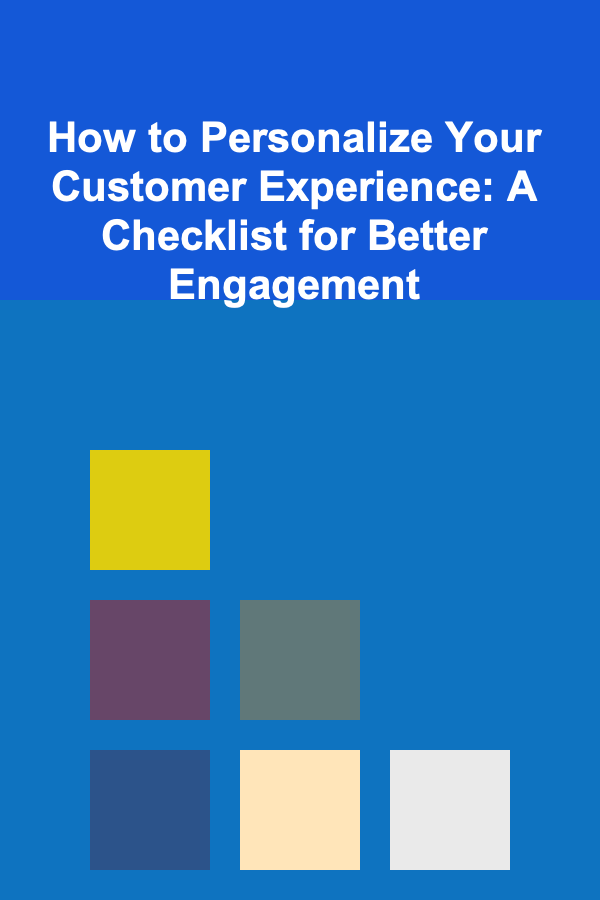
How to Personalize Your Customer Experience: A Checklist for Better Engagement
ebook include PDF & Audio bundle (Micro Guide)
$12.99$10.99
Limited Time Offer! Order within the next:

In today's competitive business environment, providing a personalized customer experience (CX) has become a key factor for success. Customers no longer settle for generic interactions; they expect brands to know them, understand their preferences, and deliver customized solutions. Personalization fosters stronger relationships, improves engagement, and boosts customer loyalty.
However, personalizing the customer experience is not as simple as throwing a customer's name into an email or recommending products based on past purchases. It requires strategic planning, data collection, and a commitment to understanding and anticipating customer needs. In this guide, we'll explore actionable steps to personalize your customer experience effectively and provide a checklist to ensure better engagement.
Understand Your Customers Deeply
The foundation of personalized experiences is knowing who your customers are, what they like, and how they engage with your brand. You cannot provide a personalized experience if you don't understand their needs, preferences, and pain points.
Key Steps:
- Customer Segmentation: Divide your customer base into segments based on demographics, behavior, purchasing patterns, or other characteristics. This allows you to target different groups with relevant messaging and offers.
- Use Data Analytics: Leverage data from your website, CRM systems, and social media to gain insights into customer behavior. Tools like Google Analytics, customer feedback surveys, and social listening can help you understand what customers want.
- Conduct Surveys and Interviews: Ask customers directly about their preferences, challenges, and desires. This data is invaluable in tailoring your services to meet their expectations.
Tools to Use:
- Google Analytics
- CRM systems like Salesforce or HubSpot
- Social listening tools like Hootsuite or Brandwatch
Deliver Personalized Content
Content is a powerful tool for building a connection with your audience. Personalized content helps customers feel that your brand speaks to them directly, rather than as part of a larger, faceless group.
Key Steps:
- Create Dynamic Website Content: Personalize the content customers see when they visit your website based on their browsing history or geographic location. For example, show them products they've previously viewed or similar items they may like.
- Tailor Email Campaigns: Use customer data to segment your email list and send targeted messages. Personalized emails (based on past purchases, preferences, or behavior) have higher open and click-through rates compared to generic ones.
- Provide Relevant Recommendations: Use AI and machine learning algorithms to offer personalized product recommendations based on a customer's past interactions, purchases, or behavior on your website. For instance, if a customer frequently buys outdoor gear, suggest related items such as camping equipment.
Tools to Use:
- Email marketing platforms like Mailchimp, Klaviyo
- Content management systems (CMS) with personalization features like WordPress, Wix, or Drupal
- Recommendation engines like Dynamic Yield or Algolia
Customize the User Journey
Every customer interacts with your brand in a unique way. Personalizing the entire customer journey---from initial interaction to post-purchase---ensures a seamless and tailored experience that encourages further engagement.
Key Steps:
- Personalized Landing Pages: Create landing pages that reflect the specific needs or interests of the customer. If they've previously visited a product page, display related items, testimonials, or product reviews.
- Tailored Onboarding: For new customers, design an onboarding experience that's based on their preferences or needs. This is especially important for SaaS products, where the onboarding process can significantly impact user engagement.
- Use Behavioral Triggers: Implement behavioral triggers like cart abandonment emails, personalized discounts, or follow-ups after a customer interacts with a particular product. These triggers show customers that you're paying attention to their actions and care about their experience.
Tools to Use:
- Marketing automation platforms like HubSpot or Marketo
- User behavior tracking tools like Hotjar or Crazy Egg
- CRM systems with workflow automation features
Provide Personalized Customer Support
Exceptional customer support is a cornerstone of a personalized customer experience. Offering tailored solutions to individual problems makes customers feel valued and enhances their overall satisfaction with your brand.
Key Steps:
- Use Customer Data to Resolve Issues Faster: Empower your customer support team with customer data, so they can immediately access relevant information like past interactions, preferences, and product history. This helps them resolve issues more quickly and accurately.
- Offer Multiple Communication Channels: Customers want to engage with brands on their terms. Whether through live chat, social media, phone support, or email, offering a variety of communication channels allows for greater convenience.
- Implement Self-Service Options: Many customers prefer solving problems on their own. Offering self-service tools such as FAQs, knowledge bases, and instructional videos can enhance the experience. Ensure these resources are also tailored to customers' needs and behaviors.
Tools to Use:
- Customer service platforms like Zendesk, Intercom, or Freshdesk
- Live chat tools like Drift or Tidio
- Knowledge base platforms like Help Scout or Document360
Personalize Your Loyalty Programs
Loyalty programs are an excellent way to reward customers for their continued engagement. However, generic loyalty programs can feel impersonal. A personalized program based on customers' buying habits and preferences will encourage deeper brand loyalty.
Key Steps:
- Reward Based on Customer Behavior: Rather than offering the same rewards for all customers, tailor rewards based on customer behavior. For example, offer discounts on products they've previously purchased or special offers related to their most frequently bought items.
- Offer Tiered Rewards: Create a tiered loyalty program where customers can unlock new benefits based on their engagement level or purchase history. This motivates customers to make repeat purchases to unlock better rewards.
- Send Personalized Offers and Discounts: Use customer data to send tailored discount offers based on their preferences, frequency of purchases, or even their birthday.
Tools to Use:
- Loyalty program platforms like Smile.io, LoyaltyLion, or Yotpo
- CRM tools with loyalty program features
- Email automation tools like Omnisend or Klaviyo
Leverage Social Media for Personalized Engagement
Social media offers an opportunity for brands to directly connect with customers on a personal level. Tailoring your social media strategy to engage customers in a personalized manner can significantly enhance their loyalty.
Key Steps:
- Engage with Customers Individually: Respond to comments, direct messages, and mentions with a personalized touch. Addressing customers by name and responding thoughtfully shows you're listening.
- Run Personalized Social Media Ads: Use customer data and segmentation to create personalized social media ads. For example, target users who have previously interacted with your brand or shown interest in particular products.
- Create Personalized Content: Share content that resonates with your customers' interests or needs. For instance, if you know a customer loves a particular product category, create content around that category and tag them in it.
Tools to Use:
- Social media management tools like Buffer, Hootsuite, or Sprout Social
- Facebook and Instagram's advanced targeting options
- Analytics tools like Socialbakers or Sprinklr
Continuously Optimize and Test Your Personalization Efforts
Personalization isn't a one-time effort; it's an ongoing process. To remain relevant and effective, you need to continuously test and optimize your personalization strategy based on performance and customer feedback.
Key Steps:
- A/B Testing: Regularly conduct A/B tests on different aspects of your personalized experience, from email campaigns to product recommendations. Testing allows you to find what works best and optimize accordingly.
- Gather Feedback: Ask your customers about their experiences with personalization. Use surveys, feedback forms, or direct interactions to learn what's working and what needs improvement.
- Track Key Metrics: Monitor engagement metrics, such as open rates, click-through rates, and customer satisfaction scores, to measure the success of your personalized efforts. These insights will guide your future personalization strategies.
Tools to Use:
- A/B testing tools like Optimizely or VWO
- Survey tools like SurveyMonkey or Typeform
- Analytics platforms like Google Analytics, Mixpanel, or Amplitude
Conclusion
Personalizing the customer experience is no longer a luxury; it's an expectation. By understanding your customers, delivering personalized content, tailoring the user journey, providing customized support, and leveraging social media, you can significantly enhance engagement and build stronger customer relationships.
This checklist for personalization offers actionable steps to create a more individualized experience for your customers, helping you to stand out in a crowded market and build long-term loyalty.

How to Create DIY Crafts for Family Bonding
Read More
How to Keep Your Music Equipment Dust-Free and Neat
Read More
How to Organize Your Favorite Recipes Using Technology
Read More
How to Sell Your Antique Books Through Online Book Communities: A Detailed Guide
Read More
How to Use Home Automation for Increased Security
Read More
How to Use Tiered Organizers for Small Beauty Items
Read MoreOther Products

How to Create DIY Crafts for Family Bonding
Read More
How to Keep Your Music Equipment Dust-Free and Neat
Read More
How to Organize Your Favorite Recipes Using Technology
Read More
How to Sell Your Antique Books Through Online Book Communities: A Detailed Guide
Read More
How to Use Home Automation for Increased Security
Read More